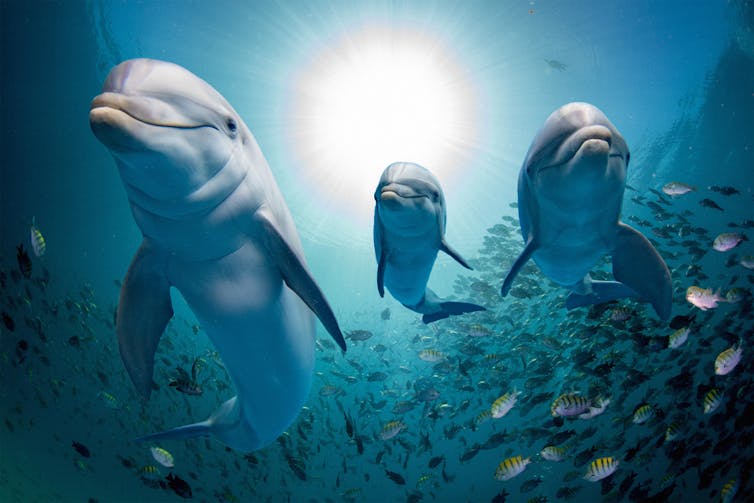Author is an Assistant Professor in the Schulich School of Law at AVﺝﻙﭺﻅﺎﺟ.
Watching captive whales or dolphins for entertainment will eventually become a thing of the past in Canada. Lawmakers recently adopted the Ending the Captivity of Whales and Dolphins Act ﻗ dubbed , named after the 1993 hit movie.
prohibits keeping, breeding and importing marine mammals from the ) for entertainment or for any other reason besides rescue and rehabilitation. Now-retired senator Wilfred Moore sponsored the bill after and the sea park industry.
The only captive whales or dolphins in Canada are now at Marineland in Ontario near Niagara Falls and the Vancouver Aquarium. The latter announced and only . There are , including Kiska, the lone ﻗkiller whale,ﻗ or orca, captive in Canada. Kiska and the at Marineland wonﻗt be freed by the bill, because the ban exempts those already in captivity.
Protecting marine mammals is important and Canada has made itself a leader through the passage of Bill S-203. A , such as Costa Rica, India and Switzerland, prohibit displaying cetaceans for entertainment. In the U.S., some states or counties have banned display and the country strictly regulates the import of wild-caught cetaceans.
With Bill S-203, Canada becomes the first North American country to ban both displaying for entertainment and importing or exporting.

Not progressive enough
As a professor of animal law, I was delighted to see this bill become law, but I am also aware that Canadian law relating to non-human animals is not progressive enough.
, the animal cruelty provision in Canadaﻗs criminal code has been interpreted to exempt most common farming practices from its application.
Instead, where animalsﻗ lives on farms are concerned, farms are subject to created primarily by industry stakeholders. These codes are referred to in some, but not all, provincial animal protection laws. They set out minimum standards based on common farming practices and they contain weak enforcement mechanisms. Legal pressure brought to bear on farms is mostly driven by complaints.
With respect to the welfare of farmed animals, . Compare this situation with the stiff maximum penalty of up to $200,000 for now bringing whales or dolphins into captivity and the .
What Bill S-203 does not address are the interests of the hundreds of millions of other sentient animals ﻗ ﻗ captive on industrial farms for the purpose of producing food.
Shifting legal landscape
To be sure, there are differences between animals held captive for our entertainment and those raised for food. Humans need to eat; we donﻗt need to visit a marine park or aquarium to survive.
But as the field of animal law continues to grow, so does public awareness of the problems with the inconsistent ways that Canadian law protects some animals, while leaving others behind.
And the legislature is beginning to take notice. In addition to Bill S-203, the import and export of shark fins and related to the offences of animal fighting and bestiality. But there remains work to be done.
Canadaﻗs Bill S-203 debate touched on the intellectual and social properties of dolphins and whales. During the debate on the bill, Sen. Moore argued:
ﻗWhales, dolphins and porpoises, which together are known as cetaceans, are highly intelligent, emotional and social mammals that roam vast distances in the oceans. In the wild, many species of whales and dolphins live in large family groups, or pods, that can grow to over 100 members. Distinct populations communicate using complex vocalizations that resemble languages.ﻗ
Elizabeth May, leader of the Green Party, and a sponsor of the bill, argued that ﻗthe science increasingly makes us understand that what might seem to be simple entertainment and a simple pleasure is actually animal cruelty, because these animals cannot be held in a swimming pool withoutﻗ۵real pain and a loss of social contact and normal activities.ﻗ
Defenders of the bill reminded Parliament that their offices had heard overwhelming support for the bill from their constituencies. They argued Canadians are no longer willing to abide keeping these animals captive in unnatural environments or forcing them to perform tricks for food.
Sentient, intelligent, social
In following the evolution of Bill S-203, I found myself wondering what the world might look like if similar arguments were used to ground reform to the practices related to animals in agriculture ﻗ animals that are similarly sentient, intelligent and social.
Hens, for example, can anticipate the future and demonstrate self-control, according to . On Canadian farms, however, egg-producing hens continue to be housed in , where they cannot spread their wings or engage in natural behaviours.
Research suggests that . And yet, it is common knowledge that pregnant sows on industrial farms are confined in barren metal crates, where they are unable to turn around, for weeks or even months at a time.
Canada should be applauded for freeing Willy from captivity. But the true celebrations should be reserved for when Canadians, as a progressive and compassionate society, decide itﻗs time to free Babe.![]()
which features includes relevant and informed articles written by researchers and academics in their areas of expertise and edited by experienced journalists.
AVﺝﻙﭺﻅﺎﺟ is a founding partner of The Conversation Canada, an online media outlet providing independent, high-quality explanatory journalism. Originally established in Australia in 2011, it has had more than 85 commissioning editors and 30,000-plus academics register as contributors. A full list of articles written by AVﺝﻙﭺﻅﺎﺟ academics can be found onﺡ .

